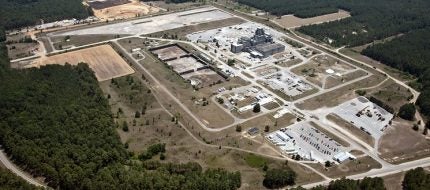
Some six years after it was first announced, the US Department of Energy (DOE) has transitioned landlord responsibilities at the Savannah River Site (SRS) from the Office of Environmental Management (EM) to the National Nuclear Security Administration (NNSA) from the start of federal fiscal year 2025.
Landlord responsibilities include the primary authority, accountability and stewardship responsibilities of SRS. All other non-landlord federal entities at SRS are referred to as tenants, which also describes EM’s new role at the site.
SRS was built in the 1950s to produce materials for nuclear weapons, primarily tritium and plutonium-239. Five reactors were built on the site along with two chemical separations plants, a water extraction plant, nuclear fuel and target fabrication facility and waste management facilities. Savannah River faces a massive legacy waste clean-up task. The 310-square-mile site is located near Aiken, South Carolina, on the Savannah River, which borders South Carolina and Georgia. SRS covers 198,046 acres, including parts of Aiken, Barnwell and Allendale counties in South Carolina. The SRS annual budget is approximately $3.8bn, with a workforce of about 13,400.
NNSA, established by Congress in 2000, is a semi-autonomous agency within DOE responsible for enhancing national security through the military application of nuclear science. NNSA maintains and enhances the safety, security, and effectiveness of the US nuclear weapons stockpile. NNSA’s expanded footprint goes beyond its long history of success in tritium operations to include providing the backbone of plutonium pit production and continuing to expand its plutonium disposition capabilities. SRS joins other sites such as the Los Alamos National Laboratory, the Nevada National Security Sites, and the Pantex Plant under the direct responsibility of NNSA.
“With the growth in NNSA missions coming to SRS, a shift in landlord responsibilities made sense,” said Mike Budney, Manager, DOE-Savannah River Operations Office. “While we are no longer responsible for the day-to-day administration of SRS; we are not going anywhere; we’ll be here until the job is done on our environmental cleanup mission.”
Michael Mikolanis, Manager, NNSA-Savannah River Field Office said: “We could not be more excited about what this means for the Site. We understand that the unique capabilities at SRS, its strong production culture, and the support from the surrounding communities, are something NNSA will need to leverage as a permanent piece of the nuclear security enterprise for years to come.”
Doe says the effort to bring the landlord transition opportunity to a reality was a significant undertaking, requiring the combined effort and commitment of employees across SRS. It included the transition of the multi-billion dollar management and operating contract, the protective force security contract, the responsibility for the Savannah River Ecology Laboratory and US Forest Service interfaces, along with other major utility and infrastructure contracts with Dominion Energy South Carolina, Ameresco, and CSX Transportation. In addition, approximately $180m of budget scope and 85 full-time federal positions moved from EM to NNSA.






